| |

Once again, our schedule put us out on the road while the uniformed students were
walking to school. The early starts are not accidental. It a nice
time of day to travel and it tends to provide interesting glimpse into local
life. When students are on the move there is a ribbon of color because
they wear color coordinated uniforms. Blue shirts seemed to be the most popular color for
uniforms, but some schools had pink, beige and yellow shirts.
Bicycling in Cameroon, greeting are the order of the day, all day, every day.
It is fun to watch the younger students egging on their buddies to greet the
strange looking foreigners. Then when a greeting comes back the spigot is
open and everyone wants to be greeting. The sounds of greetings in the
back travels forward faster than the bicycle and the students start turning to
look, like a wave going down the side of the road.
 The
frequency of greeting might raise to hundreds a minute. It may not be
until the students are lined up for their morning assembly and later go into
their classrooms than the roadside populations thins and a more manageable level
of greeting resumes. The
frequency of greeting might raise to hundreds a minute. It may not be
until the students are lined up for their morning assembly and later go into
their classrooms than the roadside populations thins and a more manageable level
of greeting resumes.
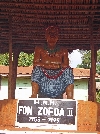
The most overwhelming experience of the day was visiting the museum and
the palace of the Fon, or paramount chief, of Babungo. The Fon is the
social, political, economic and ritual leader of his people. The current
Fon, Ndofua Zofoa III, the 25th Fon of Babungo, was enthroned in 1999 (age ~25), after the
death of his father. Unfortunately we didn't meet the Fon on our visit.
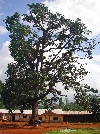 The
Babungo have live in the Upper Nun Valley for centuries, but their museum and
palace have only been open to visitors since 2006. The museum and palace
are impressive both because of quality and quantity. It is amazing that
the Fon was about to keep so much of the chieftaincy's art and ritual objects in
their own collection while so much of the physical culture of Africa had been
spirited off to high end commercial art galleries in Paris, London, Rome and New
York. A
small selection (several dozen out of The
Babungo have live in the Upper Nun Valley for centuries, but their museum and
palace have only been open to visitors since 2006. The museum and palace
are impressive both because of quality and quantity. It is amazing that
the Fon was about to keep so much of the chieftaincy's art and ritual objects in
their own collection while so much of the physical culture of Africa had been
spirited off to high end commercial art galleries in Paris, London, Rome and New
York. A
small selection (several dozen out of
 several
thousand pieces) of the most significant, highest quality pieced were are
displayed in the museum (carved and beaded thrones, stools, staffs, musical several
thousand pieces) of the most significant, highest quality pieced were are
displayed in the museum (carved and beaded thrones, stools, staffs, musical instruments,
jewelry, masks, containers, pipes, etc.) No photography is allowed in the museum
so will have to either visit, image or buy the
catalogue to appreciated that part of the collection. The quantity element
can be viewed at the palace. In the court of the palace there are instruments,
jewelry, masks, containers, pipes, etc.) No photography is allowed in the museum
so will have to either visit, image or buy the
catalogue to appreciated that part of the collection. The quantity element
can be viewed at the palace. In the court of the palace there are
 thousands
of sculptures lining the walls -- literally stacked to thousands
of sculptures lining the walls -- literally stacked to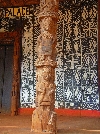 the rafters, and hanging
from them as well. Also impressive is the coverage of the art; every wall
is decorated, every pillar and door frame carved. A lot of the work
displayed royal symbols like the double gong, leopard, tortoise, lizard and
two-headed snake. the rafters, and hanging
from them as well. Also impressive is the coverage of the art; every wall
is decorated, every pillar and door frame carved. A lot of the work
displayed royal symbols like the double gong, leopard, tortoise, lizard and
two-headed snake.
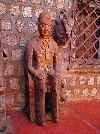 The
collection demonstrates the versatility and dynamics of African art. As
new experiences and new materials were introduced into the society they were
incorporated into the cultural realm. A couple of examples are statues of
African The
collection demonstrates the versatility and dynamics of African art. As
new experiences and new materials were introduced into the society they were
incorporated into the cultural realm. A couple of examples are statues of
African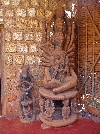 men in
Western dress, a chair that was carved after the Fon visited India that contains
both African and Hindu elements and the beadwork that started to be applied to pieces after they
became easily available through trade. men in
Western dress, a chair that was carved after the Fon visited India that contains
both African and Hindu elements and the beadwork that started to be applied to pieces after they
became easily available through trade.
 Our
escort during our visit was the Fon's wife (the Queen) and her young daughter
(far right in the picture to the left.)
While we were there the mother of the Fon, Nchio (mother of the people),
was also visiting. The Nchio is traditional one of the most important and
powerful people in highly hierarchical Babungo
society. She is responsible for the well-being of the people and sort of a
chief-of-staff of the palace. Among her responsibilities are resolving
minor disputes amongst the royal
family, educating and training the king's new wives. The Queen was great
about answering questions that were directed to her, but she otherwise wasn't
forthcoming with information, not even with general overviews about where we
were in the palace or what we were looking at. Our
escort during our visit was the Fon's wife (the Queen) and her young daughter
(far right in the picture to the left.)
While we were there the mother of the Fon, Nchio (mother of the people),
was also visiting. The Nchio is traditional one of the most important and
powerful people in highly hierarchical Babungo
society. She is responsible for the well-being of the people and sort of a
chief-of-staff of the palace. Among her responsibilities are resolving
minor disputes amongst the royal
family, educating and training the king's new wives. The Queen was great
about answering questions that were directed to her, but she otherwise wasn't
forthcoming with information, not even with general overviews about where we
were in the palace or what we were looking at.
 Another powerful group
in the palace hierarchy is the retainers to the Fon. They
have there own traditional building on the grounds. As outsiders we were
not allowed to approach it, but we were allowed to photograph the exterior. Another powerful group
in the palace hierarchy is the retainers to the Fon. They
have there own traditional building on the grounds. As outsiders we were
not allowed to approach it, but we were allowed to photograph the exterior.
The following block of photos are more views of the palace court:
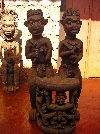
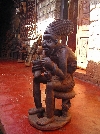
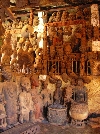
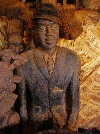
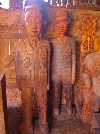
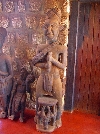
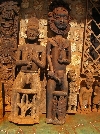
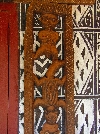








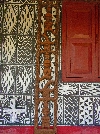
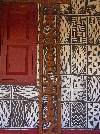
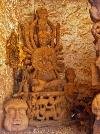






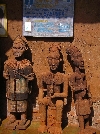

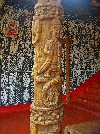
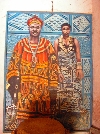
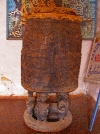
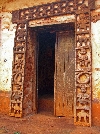
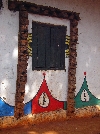
 After
Babungo we continued across another section of the Upper Nun Valley. At
one point we past fields that used to be part of the Upper Nun Valley
Development Authorities rice project. A few years back the After
Babungo we continued across another section of the Upper Nun Valley. At
one point we past fields that used to be part of the Upper Nun Valley
Development Authorities rice project. A few years back the
 project
collapsed from mismanagement and some the fields had been parceled out to
individual farmers. A lot of the fields looked like they had been abandon
-- more overgrown that would be the case if they were just being left fallow. project
collapsed from mismanagement and some the fields had been parceled out to
individual farmers. A lot of the fields looked like they had been abandon
-- more overgrown that would be the case if they were just being left fallow.
 At one point, on the rocky, potholed, dirt road, there was a sign for a "bump
ahead" (left). We so few signs in general, it is a curiosity why this one
has prevailed, and exactly which bump are they trying to alert us to.
At one point, on the rocky, potholed, dirt road, there was a sign for a "bump
ahead" (left). We so few signs in general, it is a curiosity why this one
has prevailed, and exactly which bump are they trying to alert us to.
 More common than road signs, every village seems to have a sign for their local
AIDS control committee. Our best understanding of the work of the local
AIDS control committee is they sponsor programs. The programs seem to be
speakers, theater or other presentations on health and the roll of the committee
is to be the local host and help recruit an audience for the program.
More common than road signs, every village seems to have a sign for their local
AIDS control committee. Our best understanding of the work of the local
AIDS control committee is they sponsor programs. The programs seem to be
speakers, theater or other presentations on health and the roll of the committee
is to be the local host and help recruit an audience for the program.

 The
further away from Bamenda the less Western influence was visible along the side
of the road. More house are made of clay walls and thatched roofs.
It was also common to see people walking with traditional backpacks.. While they
were reluctant to be photographed, we found some hanging along the road. The
further away from Bamenda the less Western influence was visible along the side
of the road. More house are made of clay walls and thatched roofs.
It was also common to see people walking with traditional backpacks.. While they
were reluctant to be photographed, we found some hanging along the road.









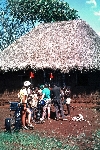
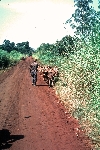
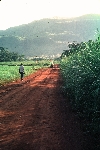
 It
is very common to see local produce for sale along the side of the road.
This house was selling coco-yams, casava (manioc) and plantains. The
buyers are generally in cars passing by, heading for the bigger towns. It
is very common to see local produce for sale along the side of the road.
This house was selling coco-yams, casava (manioc) and plantains. The
buyers are generally in cars passing by, heading for the bigger towns.
 We
hadn't traveled very far at Babessi, but after the long visit at the Fon of
Babungo's compound it was late morning so we were in need of nourishment again.
As seems to generally be the case the choices at hand were more bars than
restaurants. Bucking the trend we opted for sodas and food. We
hadn't traveled very far at Babessi, but after the long visit at the Fon of
Babungo's compound it was late morning so we were in need of nourishment again.
As seems to generally be the case the choices at hand were more bars than
restaurants. Bucking the trend we opted for sodas and food.
As is the case on the Ring Road, there was another hill in our future. It
was paved around the turn of the century, but even so it afforded an opportunity
for cross-training -- giving our walking muscles a bit of a workout in addition
to the bicycling muscles, which were certainly getting a workout. Walking
also gives you more time and opportunities to soak in the scenery and talk to
people along the road. This road has some very big views.




 The road to Jakiri, 20 years apart.
The road to Jakiri, 20 years apart.

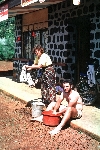
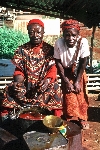
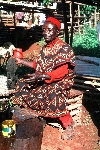 In
Jakiri we had a chance to catch-up on some chores and visit the market. The
couple selling palm oil allowed us to take some pictures. They said the oil
comes from the lowlands (Fako District). In
Jakiri we had a chance to catch-up on some chores and visit the market. The
couple selling palm oil allowed us to take some pictures. They said the oil
comes from the lowlands (Fako District).
Linguistically we were in the Narrow Grassfields>Ring group most of the day.
Around Ndop they speak Bamunka (Ring>North). In Babungo they speak Vengo
(Ring>North). In Baba the root is a little different in that they speak Baba (Mbam-Nkam>Nun). In Babesi
they speak Wushi (Ring>North). In Bamessing they speak Kenswei Nsei
(Ring>North). And in Jakiri they speak Oku (Ring>Central) and Lamnso' (Ring>East). The interesting mystery of the
assignment of these linguistic relationships is the oral history of the all the
 Ring
languages trace their origins
back to the Tikar, who moved south from north central Cameroon because of
pressure from groups like the Fulani. The classification of Tikar is
Bantoid>Southern>Tikar>Tikar, but the classification of the Ring languages is Bantoid>Southern>Wide Ring
languages trace their origins
back to the Tikar, who moved south from north central Cameroon because of
pressure from groups like the Fulani. The classification of Tikar is
Bantoid>Southern>Tikar>Tikar, but the classification of the Ring languages is Bantoid>Southern>Wide Grassfields>Narrow Grassfields>Ring, which indicates that
the split came before the establishment of Tikar. So it seems that either the
linguist have something wrong or there is something skewed in the oral history. Grassfields>Narrow Grassfields>Ring, which indicates that
the split came before the establishment of Tikar. So it seems that either the
linguist have something wrong or there is something skewed in the oral history.
|
Addendum:
The
asphalt that was so delightful yesterday ended shortly outside of Ndop. It
reappeared periodically until we reached Kumbo, mostly on the big hills, but
never for as long as the stretch from Bamenda to Ndop and not even always for
steep sections, which were deeply rutted when they were unpaved. It is
tough to figure out exactly what the pattern was and what the criteria might be.
|











































































 Please
contact us
Please
contact us